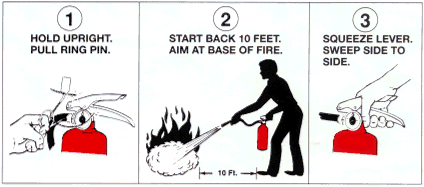Fire Extinguisher Notes
Before you ever ignite your first flame, you need to make sure you have some way of easily extinguishing it. Whether you are working with fireworks, fuels or fire tools, it is very important to think about how you will extinguish them when you are finished.
When you are using fireworks, you should always have at least a bucket of water, a wet towel, your address and a water hose ready. In addition, having a water-based fire extinguisher is extremely handy—especially if you are in an area that doesn't have a water hose.
When working with fire props such as clubs, chains, staves, etc., it is recommended that you use Carbon Dioxide (CO2) fire extinguisher, a wet towel and a bucket of water. A wet towel is needed to extinguish the prop. When putting out fire props, a CO2 fire extinguisher is preferable to use since carbon dioxide is a clean gas that leaves no residue, which means there is no mess to clean after discharge compared to water or dry chemical. Since there is no residue, it is easier to refuel and re-light props. CO2 will not damage electrical equipment. It will hold a charge until empty (dry chemical will lose gas after a single discharge) and is cheap to refill.
Fire extinguishers that use water are also recommended. The downside to using water is that props must be thoroughly dried before they can be refueled and used again.
Although dry chemical extinguishers meet the safety code; they make a mess after discharging that must be immediately cleaned up. The residue from the extinguishers makes it very difficult to re-light or refuel props so the props must be thoroughly cleaned before each use. Dry chemical extinguishers will start to lose gas after one single discharge and must be immediately serviced and refilled which is expensive.
Beyond that, the powder produced when discharging a fire extinguisher is actually a bit of a hazard. The discharge must be cleaned up immediately after a discharge. Some people find the powder to be an irritant.
Extinguisher Types |
Characteristics |
Size |
Horizontal Range |
Discharge Time |
Dry Chemical |
Discharges a white or bluish cloud. Leaves residue that must be thoroughly cleaned after extinguishment. Dry chemical will lose gas after a single discharge. |
2 to 10 lb. |
6 - 10 ft. |
8 - 25 seconds |
Multipurpose Dry Chemical |
Discharges a yellow cloud. Leaves residue that must be thoroughly and quickly cleaned after extinguishment. Dry chemical will lose gas after a single discharge. |
2.5 - 10 lb. |
5 - 10 ft. |
8 - 25 seconds |
Foam AFFF |
A chemical agent when discharged forms a foamy solution. Protect from freezing. |
2.5 gallon |
20 - 25 ft. |
30 seconds |
Carbon Dioxide (CO2): |
Type: BC Basically an inert gas that discharges a white vapor. Leaves no residue. Can freeze items when applied. Does not need protection from freezing. |
5 - 10 lb. |
3 - 8 ft. |
8 - 12 seconds |
Water |
Discharges a solid stream. Protect from freezing. |
2.5 gallon |
30 - 40 ft. |
1 minute |
Extinguisher Symbols
Extinguisher Type |
Characteristics |
A - Alpha |
Extinguishers suitable for 'Class A' fires should be identified by a triangle containing the Green Triangle letter 'A'. This type of extinguisher is used for ordinary combustibles such as paper or wood. If colored, the triangle shall be colored green. |
B - Bravo |
Extinguishers suitable for 'Class B' fires should be identified by a square containing the Red Square letter 'B'. This type of extinguisher is used for flammable liquids such as grease, oil or gasoline. If colored the square shall be colored red. |
C - Charlie |
Extinguishers suitable for 'Class C' fires should be identified by a circle containing the Blue Circle letter 'C'. This type of extinguisher is used for electrical fires. If colored, the circle shall be colored blue. |
D - Delta |
Extinguishers suitable for 'Class D' fires should be identified by a five pointed star Yellow Star containing the letter 'D'. This type of extinguisher is used for combustible metals such as magnesium, titanium or aluminum. If colored, the star shall be colored yellow. |
K - Kilo |
This type of extinguisher is used for fires in cooking appliances that involve combustible cooking media such as vegetable or animal oils and fats. |
How to Operate an Extinguisher
The key to remember is PASS - Point, Aim, Squeeze and Sweep.
- Hold extinguisher upright. Twist/pull ring pin.
- Remove nozzle/horn. Start back 8 feet and aim at the base of the fire.
- Squeeze lever and hold it open. Sweep slowly from side to side.

Written by Wally Glenn
Edited by Neil Carlberg, Maque Da Vis and Daniel Walsh.